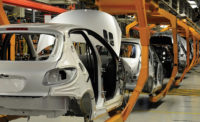Stevens Manufacturing Conquers Quality with Dynamic Measurement Duo
Portable, multi-function CMM ensures dimensional integrity of every part.

Every part that comes under the Stevens Manufacturing roof is validated, even if is finished. Two inspectors are reviewing a customer’s specifications before the part is scanned using a portable CMM. Source: Hexagon Metrology

Jim Christiani, a veteran inspector, uses a portable ROMER arm to scan a part. Due to the density of the scan, he can readily spot surface anomalies, such as a missed cut on a part or bad cutter paths that would not be readily evident with point-to-point measurement. Source: Hexagon Metrology

Dave Warncke, a highly experienced inspector at Stevens, uses the portable ROMER arm with scanning and probing capabilities to ensure a finished part fits within the customer’s dimensional parameters. Source: Hexagon Metrology

The ROMER arm was purchased for its larger measurement volume and the ability to scan and acquire data in a much shorter time. With a faster process, the inspectors can spend more time analyzing parts offline. Source: Hexagon Metrolog




Smack in the middle of a growing manufacturing company is an inspection department focused on stringent part verification. The demands of a high-paced environment require technicians to think and work fast. The underlying necessity for the technology they use is real-time measurement data to combat day-to-day shop floor challenges. This essential process lifeline enables Stevens Manufacturing Company to keep a continuous eye on quality and precision.
Serving the aerospace, military and commercial industries since 1956, Stevens Manufacturing (Milford, CT) is a private equity-owned enterprise on the upswing. The company specializes in complex, monolithic machining and assembly with the ability to inspect close tolerance parts. Their AS9100 and ISO9001 certifications are a reflection of company’s constant improvement philosophy to stay in front of technologies, processes, materials and industry standards.
The wheels are in motion to transition Stevens Manufacturing from a regional New England-based machine shop to a nationwide airframe supplier. Construction is underway to nearly double their current facility to over 62,000 sq. ft. The production of larger components within a 120” x 71” envelope spurred their need for more operational space for machining, assembly and quality control. Their new CNC machines alone have a footprint larger than a standard-sized room. During this growth spurt, in-house experts are focused on implementing new technologies that not only give them a competitive edge, but raise the process efficiency bar as well.
Hexagon Manufacturing Intelligence250 Circuit Drive North Kingstown, RI 02852 (401) 886-2000 |
MODEL-BASED INSPECTION
Six years ago, the company added a ROMER articulating arm to their inspection program due to their work with reduced dimension parts. There can be several critical dimensions found on these components, such as hole locations and true positions. Profile tolerances of .015”-.030”are sometimes provided and the operators inspect and compare the physical part to its CAD model’s surface data points. The portable coordinate measuring machine (PCMM) was used for gathering real-time coordinate data and plotting data points on solid models. It was also utilized for first article inspection (FAI) of in-house parts and incoming components for assembly work. With a quick setup, the mobile arm was on hand to solve dimensional control issues on-demand anywhere on the shop floor.
Stevens Manufacturing recently deployed a second PCMM – a 3.0 meter seven-axis ROMER Absolute Arm with an integrated scanner (Hexagon Metrology, North Kingstown, RI) to measure parts of a much larger scale. Their escalating need for faster measurement and more 3D coordinate data were the driving force behind the acquisition of the multi-purpose solution. Jim Christiani, a fifteen-year quality assurance veteran, explained the evolution, “The new arm was purchased not only for its larger measurement volume, but the laser scanner allows us to acquire more data in a much shorter time. In the past, we were checking every point one-by-one. With scanning and meshing capabilities, we run the laser line, scan the entire part, and pull a point cloud in one session. With a faster process, I can spend more time analyzing the part offline.”
The most compelling aspect of the measurement system for Stevens Manufacturing is its adaptability for a broad range of in-house applications including point cloud inspection, reverse engineering, virtual assembly and CNC milling applications. Because the system is mobile and has no warm-up time or homing procedures, a Stevens’ inspector can setup the arm and begin acquiring data in a few minutes for on-demand troubleshooting on the shop floor. The arm has a natural human feel for ease of movement around a part, and incorporates a zero-gravity counterbalance to boost operator comfort during intensive workdays. A larger measurement volume is important to the Stevens inspection department, so the arm’s length and infinite rotation in the principle axes allows them to reach hard-to-access areas or surfaces on a component.
THE RIGHT MIX OF METROLOGY
The company handles a large breadth of aerospace parts, assemblies, and parts that interact with other parts --everything from airframe components for helicopters, structural parts, flight controls including flight grips and sticks, pedal systems, shaft assemblies, parts for rotors, bearings, bell cranks, dashboard panels to nuts and bolts. The parts are generally a mix of mechanical designs and complex organic surfaces. With scanning added to the quality assurance equation, technicians get a better overall picture of the entire part. While verification can be accomplished by probing data point clusters in critical areas, but it is harder to recognize irregularities. With compare tools, meshing and color mapping to show deviations, the inspector can conduct a higher level of analysis on a scanned part and recognize aberrations like bending or warping.
“The combination of tactile probing and laser scanning that you get with a portable arm is ideal for troubleshooting in our environment,” states Christiani. “If you have any issues with the mesh derived from the scan data, you can check your work manually with tactile probing during the same work session. The secondary probe method to measure and inspect is all built into the arm, making it a lot more versatile for the work we do here at Stevens. For the size and complexity of the aerostructures we handle, model based inspection is the best solution. “
Another appreciable benefit is better visualization of the part. Due to the density of the scan, the operator can readily spot surface anomalies, such as a missed cut on a part or bad cutter paths that would not be readily evident with point-to-point measurement. Christiani explains that problem solving is also easier and more accurate with digital alignment capabilities within the software program. No longer does a part-in-question need to be setup on physical tooling points to check its integrity. The component can be scanned, digital tooling points are applied to the data, and then part is aligned to the original CAD model. This technique has saved a tremendous amount of inspection time.
DIMENSIONAL INTEGRITY IS JOB ONE
Stevens Manufacturing receives large volumes of parts from other companies for assembly jobs. While they respect other manufacturer’s FAIs, every part that comes under their roof is validated, even if is finished. They consider themselves responsible for the dimensional integrity of every component in their purview. Non-contact scanning is the key to measuring some of the most challenging parts. “We received a rubber ring and had to conduct an FAI on it. It was flimsy and flexible, and not something that could have even been measured on a comparator. We scanned the entire part without ever having to touch it,” reflects Christiani.
Inspection can often be challenging due to the number of unknown conditions of incoming parts. Having dual measurement tools has been especially useful to verify castings and die forgings that arrive in near net shape. These parts may not have surfaces to check or an engineering drawing to reference, but with scanning and probing capabilities, the Stevens inspection team can ensure a finished part fits within the customer’s dimensional parameters. The ability to reverse engineer parts has been a bonus advantage of the PCMM. A customer recently sent the inspection team a part from a supplier that had gone out of business, and wanted it inspected for suspected issues before it was manufactured. After one scanning session, the inspector could instantly spot the surface areas on the part that were not correct.
Dave Warncke, another highly experienced inspector at Stevens, shared his thoughts on the time savings achieved through the use of a scanner. “In terms of speed, you really cannot compare non-contact versus tactile data acquisition. The work session is cut in half or better. When measuring large parts, you could spend three quarters of a day probing points with a CMM. We have proved this out many times. A good example is a part that needed roughly 1,500 points verified which took three to four hours to accomplish this task. The same part was scanned and meshed in a little over an hour. I can extract the same amount of points, but the processing and reports take a little longer to complete. The end game is shaving off data acquisition time, leaving more time for critical analysis.”
NO COMPROMISES IN QUALITY
Nick Reinke, President of Stevens Manufacturing, holds the reins of the company during its major transitional period. “Stevens Manufacturing has been in business just shy of 60 years, and we honor the legacy built by founder Steven Fogler. Today, we are a value-added company positioned to serve OEMs looking for partners who can deliver a broad range of services. However, large volume component production requires the security of a well-funded corporation. As the parts get larger, material costs can go from 5% of the part to over 50% of the cost of the part. We are positioned with the financial backing to cover those raw materials,” states Reinke.
He makes no bones about the fact his company is reaching for the next level of perfection for every product.
In order to achieve this, real-time measurement intelligence has to be at the fingertips of the appropriate parties when a problem arises. With the company’s emphasis on the dimensional control process and the metrology solutions that power it, Stevens Manufacturing is stepping up to be a major contender in aerospace manufacturing.
Looking for a reprint of this article?
From high-res PDFs to custom plaques, order your copy today!









